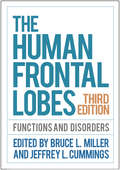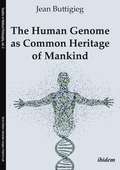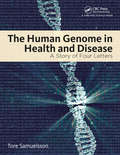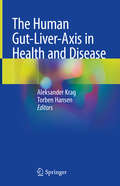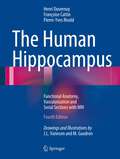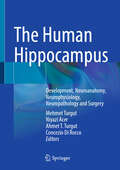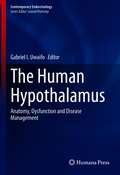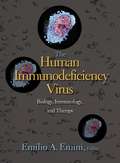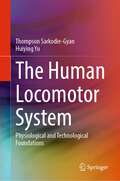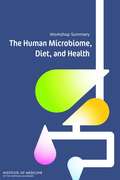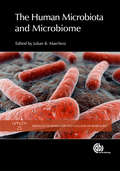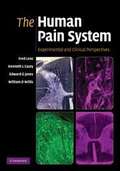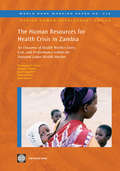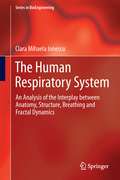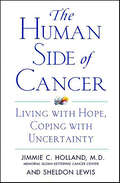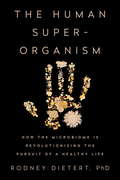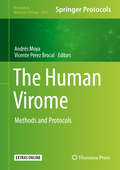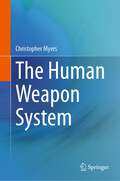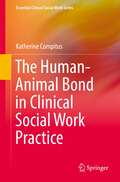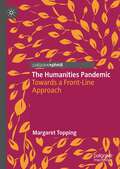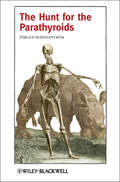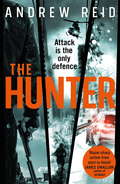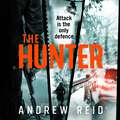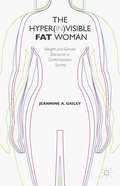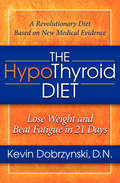- Table View
- List View
The Human Frontal Lobes, Third Edition: Functions and Disorders
by Jeffrey L. Cummings Bruce L. MillerThis authoritative work, now thoroughly revised, has given thousands of clinicians, students, and researchers a state-of-the-art understanding of the human frontal lobes--the large brain region that plays a critical role in behavior, cognition, health, and disease. Leading experts from multiple disciplines address the anatomy and chemistry of the frontal cortex, neuropsychological assessments of capabilities unique to the frontal lobes, the nature of (and possible treatment avenues for) frontotemporal dementia and related conditions, and implications for understanding and treating neuropsychiatric disorders, such as schizophrenia, mania, and depression. Illustrations include eight pages in full color. New to This Edition: *Reflects a decade of important research advances in such areas as functional connectivity mapping of frontal and frontal-subcortical circuits. *Incorporates significant new information on frontotemporal dementia and other neurological disorders. *Expanded section on neuropsychiatric disorders, with new chapters on apathy, dissociative states, and antisocial behavior. *Chapters on salience networks, normal brain aging, white matter diseases, and clinical trials. *Increased attention to brain processes involved in moral reasoning, empathy, decision making, and other key human capabilities.
The Human Genome as Common Heritage of Mankind (Studies in Medical Philosophy #2)
by Jean ButtigiegIn 1997, the UNESCO General Conference declared the human genome a common heritage of humankind. This declaration was followed by the Joint Statement of March 14, 2000, by US President Bill Clinton and British Prime Minister Tony Blair, in which they stated that the “fundamental data on the human genome, including the human DNA sequence and its variations, should be made freely available to scientists everywhere.” This announcement to allow “unencumbered access” to this fundamental data on the human genome, for the benefit of all humanity, appeared to endorse the UNESCO Declaration of 1997 on the human genome. But as it turns out, these statements were only political slogans since there is a complete lack of any genuine attempts to make the human genome a legal principle of international law so far. This study's foremost goal is to reintroduce the philosophical and political implications of the concept of common heritage of mankind into public discourse, as intended by Arvid Pardo when he addressed the UN General Assembly on November 1, 1967, and apply them to the human genome. In this timely study, Jean Buttigieg demonstrates the necessity to make it a legal principle of international law that the human genome is a common heritage of mankind. As Buttigieg demonstrates, the biggest challenge here comes from the patent system in its present form, which encourages the commercialization of the human genome by explicitly denying scientists “unencumbered access” to the fundamental raw data. By putting individual rights before community rights, the patent system effectively hinders discoveries that prompt new and better medical treatments. Buttigieg also discusses issues of biotechnology. While the biotechnology debate is very often centered on which new applications of biotechnology should or should not be permitted, it so far lacks a critical philosophical analysis of biotechnology itself. The true essence of the human genome, Buttigieg argues, is to be found in metaphysics and not biology. This study fills a gap in the literature on the human genome and the common heritage of mankind by addressing the metaphysical nature of the human genome and discussing the philosophical concerns surrounding the field of biotechnology.
The Human Genome in Health and Disease: A Story of Four Letters
by Tore SamuelssonThe human genome is a linear sequence of roughly 3 billion bases and information regarding this genome is accumulating at an astonishing rate. Inspired by these advances, The Human Genome in Health and Disease: A Story of Four Letters explores the intimate link between sequence information and biological function. <P><P>A range of sequence-based functional units of the genome are discussed and illustrated with inherited disorders and cancer. In addition, the book considers valuable medical applications related to human genome sequencing, such as gene therapy methods and the identification of causative mutations in rare genetic disorders. <P><P>The primary audiences of the book are students of genetics, biology, medicine, molecular biology and bioinformatics. Richly illustrated with review questions provided for each chapter, the book helps students without previous studies of genetics and molecular biology. It may also be of benefit for advanced non-academics, which in the era of personal genomics, want to learn more about their genome. <P><P> Key selling features: <P><P>Molecular sequence perspective, explaining the relationship between DNA sequence motifs and biological function <P><P>Aids in understanding the functional impact of mutations and genetic variants <P><P>Material presented at basic level, making it accessible to students without previous studies of genetics and molecular biology <P><P>Richly illustrated with questions provided to each chapter
The Human Gut-Liver-Axis in Health and Disease
by Torben Hansen Aleksander KragThe book brings together the current knowledge and future perspectives of the complex physiology and pathophysiology of gut-liver interactions in health and disease. It provides readers with a unique overview and access to knowledge that cannot be obtained elsewhere.The structure is logical and covers all aspect including the normal physiology, changes in various liver diseases, technology, sample collection and various interventions. Thus suitable for general reading, lookup for specific questions or as a reference book within the area.The book allows the reader to access all the knowledge that has been generated within the last 10 years in this field.
The Human Hippocampus
by Francoise Cattin Henri M. Duvernoy Pierre-Yves RisoldThis new edition, like previous ones, offers a precise description of the anatomy of the human hippocampus based upon neurosurgical progress and the wealth of medical imaging methods available. The first part describes the fine structures of the hippocampus and is illustrated with new original figures. A survey is then provided of current concepts explaining the functions of the hippocampus, and the external and internal hippocampal vascularization is precisely described. The last and main part of the book presents serial sections in coronal, sagittal, and axial planes; each section is accompanied by a drawing to explain the MR 3T images. The new edition is also enriched by several MRI views of major hippocampal diseases. This comprehensive atlas of human hippocampal anatomy will be of interest to all neuroscientists, including neurosurgeons, neuroradiologists, and neurologists.
The Human Hippocampus: Development, Neuroanatomy, Neurophysiology, Neuropathology and Surgery
by Mehmet Turgut Concezio Di Rocco Ahmet T. Turgut Niyazi AcerWritten and edited by leading international authorities in the field, this book provides an in-depth review of knowledge of human hippocampus, and role of the hippocampus in memory, cognition and learning. It includes informative chapters organized into two main groups: (1), fundamental information about the human hippocampus, including history, development, neuroanatomy, neurophysiology, neuropathology, structural and synaptic plasticity, volume, 3D visualition of the human hippocampus and etc.; and (2) role of the hippocampus in memory, cognition and learning, including role of the hippocampus in cognition, time and memory, learning and etc. There are some unique features about this book: cross-references within chapters to highlight connections between development, anatomy, physiology, pathology, and surgery, real-world examples to illustrate key points and practical applications, summaries of the latest research to keep readers informed of cutting-edge developments. Thus, this comprehensive reference book will be an ideal source for neuroscientists at all levels, from graduate students to researchers in specific disciplines studying this region including neurosurgeons, neurologists, neuroradiologists, neuroanatomists and psychiatrists who seek both basic and more advanced information regarding the human hippocampus.
The Human Hypothalamus: Anatomy, Dysfunction and Disease Management (Contemporary Endocrinology)
by Gabriel I. UwaifoThe hypothalamus is an anatomically small but functionally important part of the brain. In functional and pathophysiological terms, the hypothalamus represents the intersection of several areas of clinical and medical expertise. The human hypothalamus can be astutely referred to as the crossroad of endocrinology, psychiatry, neurology and neurosurgery. Because of its involvement in myriad physiologic functions and the varied ways disorders involving it can manifest, hypothalamic disease can initially come to medical attention in widely disparate settings and with widely different clinicians. Therefore, the detection and proper care of hypothalamic dysfunction and disease often requires carefully coordinated multidisciplinary care.This volume fills a significant void in the medical professional community, comprehensively presenting the scope of hypothalamic structure, function, dysfunction and disease to cater to the various clinical, teaching and research professionals that have a stake in this part of the human brain. This text captures in one place all the information that practicing clinicians, clinician scientists, and researchers need to be adequately informed about various aspects of the hypothalamus in all its complexity. It is comprehensive and broad in scope so that it provides relevant reference information for the wide range of professionals involved in the pre- and post-mortem detection, diagnosis, characterization, care and management of various hypothalamic disorders and diseases in addition to providing a sound anatomic and physiologic foundation of the normal human hypothalamus. The Human Hypothalamus can be used to differing degrees by medical professionals and students alike, finding utility for interested general clinicians, medical school and allied health professional teaching faculty as well as subspecialists in domains as wide as neurosurgery, neuroendocrinology, clinical psychiatry and neuro-oncology.
The Human Immunodeficiency Virus: Biology, Immunology, and Therapy
by Emilio A. EminiThe past few years have witnessed an explosive increase in our collective knowledge of the biology of the human immunodeficiency virus (HIV). Researchers have acquired new understanding of the virus's biochemistry, molecular biology, pathogenesis, genetics, and immunobiology. Resulting therapeutic advances have significantly prolonged the lives of thousands. Yet, the need to develop better therapies is ever more acute and--given the virus's continued spread through the human population--the need for an effective vaccine is urgent. These goals can be accomplished only through the experienced synthesis of information from the many disciplines participating in HIV research and through the insights of new investigators. This volume is designed to lower the barriers imposed on investigators by the sheer volume of available information--information that often can be found only in far-flung and specialized journals. It provides, in a single resource, an in-depth overview of the diverse areas that constitute HIV research. The result is a broad introduction for students and researchers new to the field as well as an integrated overview for researchers specialized in particular areas of HIV investigation. The volume will also benefit those seeking technical understanding of the virus's biology, including physicians treating HIV-infected patients. Each chapter is a comprehensive presentation of one area of current AIDS research--including work on the virus life cycle, epidemiology, genetics, protease and reverse transcriptase inhibitors, receptor and co-receptor interactions, therapeutic targets, clinical treatment, immunobiology, and vaccines--written by a leading researcher in that area. The contributors are Jon P. Anderson, Jan Balzarini, Elana Cherry, Thomas J. Coates, Chris Collins, Jon H. Condra, Mark B. Feinberg, Richard B. Gaynor, Matthias Götte, Daria J. Hazuda, Spyros Kalams, Nathaniel R. Landau, Gerald H. Learn, Norman L. Letvin, James I. Mullins, Willscott E. Naugler, David Nickle, Matthew Rain, Allen G. Rodrigo, Daniel Shriner, Shalom Spira, Mario Stevenson, Todd Summers, Catherine Ulich, Joseph P. Vacca, Mark A. Wainberg, Bruce D. Walker, and Yang Wang.
The Human Locomotor System: Physiological and Technological Foundations
by Thompson Sarkodie-Gyan Huiying YuThe textbook describes the complexity of the human dynamic behavior in space and its ability to produce coordinated, adaptive, dynamically stable movements under steady conditions while negotiating complex terrains and experiencing unexpected perturbations. Applying fundamental theories of biomechanics and physiology, the authors further consider the physical, perceptual, and motor aspects of the locomotor system towards the analysis of how humans can behave adaptively in space by virtue of their intelligent sensory-motor functions and to illuminate our understanding of how this complexity in behavior can provide insight into the neural control of locomotion of the musculoskeletal system. The text provides a foundation for describing the normal and abnormal human locomotor systems. The Human Locomotor System: Physiological and Technological Foundations is intended as a primary text for upper-undergraduate and graduate-level courses in neuroscience, gait analysis, kinesiology, physical therapy, sports science, and biomedical and rehabilitation engineering. It is also a valuable professional reference for scientists and engineers at medical and pharmaceutical companies involved in bioengineering research and development.
The Human Microbiome, Diet, and Health
by Institute of Medicine Food Forum Food and Nutrition Board Leslie Pray Emily Tomayko Laura PillsburyThe Food Forum convened a public workshop on February 22-23, 2012, to explore current and emerging knowledge of the human microbiome, its role in human health, its interaction with the diet, and the translation of new research findings into tools and products that improve the nutritional quality of the food supply. The Human Microbiome, Diet, and Health: Workshop Summary summarizes the presentations and discussions that took place during the workshop. Over the two day workshop, several themes covered included: The microbiome is integral to human physiology, health, and disease. The microbiome is arguably the most intimate connection that humans have with their external environment, mostly through diet. Given the emerging nature of research on the microbiome, some important methodology issues might still have to be resolved with respect to undersampling and a lack of causal and mechanistic studies. Dietary interventions intended to have an impact on host biology via their impact on the microbiome are being developed, and the market for these products is seeing tremendous success. However, the current regulatory framework poses challenges to industry interest and investment.
The Human Microbiota and Microbiome (Advances in Molecular and Cellular Microbiology)
by Larry Forney Tom van de Wiele Jia Li Takahiro Matsuki Wim Crielaard Markus Egert Ken Bruce Elaine Holmes Huiying Li Marco Ventura Andrew GoodmanThousands of different microbial species colonize the human body, and are essential for our survival. This book presents a review of the current understanding of human microbiomes, the functions that they bring to the host, how we can model them, their role in health and disease and the methods used to explore them. Current research into areas such as the long-term effect of antibiotics makes this a subject of considerable interest. This title is essential reading for researchers and students of microbiology.
The Human Pain System
by Frederick A. Lenz Kenneth L. Casey Edward G. Jones William D. WillisPain is a subject of increasing scientific and clinical interest. Studies of non-primate animal models have contributed greatly to our knowledge of pain. Nonetheless, investigators often refer to basic neuroscientific and behavioral studies of humans and non-human pain. Likewise, the interpretation of human pain studies and clinical observations relies upon understanding the relevant anatomy and physiology as gleaned from animal, and especially primate, research. Here, Lenz, Casey, Jones, and pain in humans, to provide a firm basis for understanding the mechanisms of normal and pathological human pain. This book is essential reading for anyone interested in pain research. Book jacket.
The Human Resources for Health Crisis in Zambia
by Mirja Sjöblom Agnes Soucat Christopher H. Herbst Monique Vledder Karen Campbell'The Human Resources for Health Crisis in Zambia' is part of the World Bank Working Paper series. These papers are published to communicate the results of the Bank's ongoing research and to stimulate public discussion. Despite reporting some health gains since the 1990s, health outcomes remain poor in Zambia and it will be very challenging to achieve the health-related Millennium Development Goals by 2015. The Government of Zambia recognizes that the improvement of child and maternal health and the reduction in mortality from HIV/AIDs and malaria require better access to an appropriate number of wellperforming health workers or human resources for health (HRH). This paper compiles recent evidence on the Zambian health labor market and provides some baseline information on HRH to support the government address its HRH challenges. In addition, the paper analyzes the available evidence on the national health labor market to better understand the number, distribution, and performance of HRH in Zambia.The paper also explains HRH outcomes by mapping, assessing, and analyzing pre-service education and labor market dynamics and well as the core factors influencing these dynamics. This working paper was produced as part of theWorld Bank's Africa Region Health Systems for Outcomes (HSO) Program.The Program, funded by the World Bank, the Government of Norway, the Government of the United Kingdom, and the Global Alliance for Vaccines and Immunization (GAVI), focuses on strengthening health systems inAfrica to reach the poor and achieve tangible results related to Health, Nutrition, and Population.The main pillars and focus of the program center on knowledge and capacity building related to Human Resources for Health, Health Financing, Pharmaceuticals, Governance and Service Delivery, and Infrastructure and ICT. More information as well as all the products produced under the HSO program can be found online at www.worldbank.org/hso .
The Human Respiratory System: An Analysis of the Interplay between Anatomical Structure and Breathing Dynamics
by Clara Mihaela IonescuThe Human Respiratory System combines emerging ideas from biology and mathematics to show the reader how to produce models for the development of biomedical engineering applications associated with the lungs and airways. Mathematically mature but in its infancy as far as engineering uses are concerned, fractional calculus is the basis of the methods chosen for system analysis and modelling. This reflects two decades' worth of conceptual development which is now suitable for bringing to bear in biomedical engineering. The text reveals the latest trends in modelling and identification of human respiratory parameters with a view to developing diagnosis and monitoring technologies. Of special interest is the notion of fractal structure which is indicative of the large-scale biological efficiency of the pulmonary system. The related idea of fractal dimension represents the adaptations in fractal structure caused by environmental factors, notably including disease. These basics are linked to model the dynamical patterns of breathing as a whole. The ideas presented in the book are validated using real data generated from healthy subjects and respiratory patients and rest on non-invasive measurement methods. The Human Respiratory System will be of interest to applied mathematicians studying the modelling of biological systems, to clinicians with interests outside the traditional borders of medicine, and to engineers working with technologies of either direct medical significance or for mitigating changes in the respiratory system caused by, for example, high-altitude or deep-sea environments.
The Human Side of Cancer: Living with Hope, Coping with Uncertainty
by Sheldon Lewis Jimmie C. HollandFor more than twenty years, Dr. Holland has pioneered the study of psychological problems of cancer patients and their families -- whom she calls "the real experts." In The Human Side of Cancer, she shares what she has learned from all of them about facing this life-threatening illness and what truly helps along the cancer journey. This book is the next best thing to sitting in Dr. Holland's office and talking with her about the uncertainty and anxiety elicited by this disease. And it is a book that inspires hope -- through stories of the simple courage of ordinary people confronting cancer.
The Human Superorganism: How the Microbiome Is Revolutionizing the Pursuit of a Healthy Life
by Rodney Dietert"Eyeopening... Fascinating... may presage a paradigm shift in medicine." --Kirkus Reviews (starred review)"Teeming with information and big ideas... Outstanding."--Booklist (starred review)The origin of asthma, autism, Alzheimer's, allergies, cancer, heart disease, obesity, and even some kinds of depression is now clear. Award-winning researcher on the microbiome, professor Rodney Dietert presents a new paradigm in human biology that has emerged in the midst of the ongoing global epidemic of noncommunicable diseases. The Human Superorganism makes a sweeping, paradigm-shifting argument. It demolishes two fundamental beliefs that have blinkered all medical thinking until very recently: 1) Humans are better off as pure organisms free of foreign microbes; and 2) the human genome is the key to future medical advances. The microorganisms that we have sought to eliminate have been there for centuries supporting our ancestors. They comprise as much as 90 percent of the cells in and on our bodies--a staggering percentage! More than a thousand species of them live inside us, on our skin, and on our very eyelashes. Yet we have now significantly reduced their power and in doing so have sparked an epidemic of noncommunicable diseases--which now account for 63 percent of all human deaths. Ultimately, this book is not just about microbes; it is about a different way to view humans. The story that Dietert tells of where the new biology comes from, how it works, and the ways in which it affects your life is fascinating, authoritative, and revolutionary. Dietert identifies foods that best serve you, the superorganism; not new fad foods but ancient foods that have made sense for millennia. He explains protective measures against unsafe chemicals and drugs. He offers an empowering self-care guide and the blueprint for a revolution in public health. We are not what we have been taught. Each of us is a superorganism. The best path to a healthy life is through recognizing that profound truth.From the Hardcover edition.
The Human Virome: Methods and Protocols (Methods in Molecular Biology #1838)
by Andrés Moya Vicente Pérez BrocalThis book details the most comprehensive, up-to –date, and cutting-edge protocols used in wet and dry labs to investigate the viral communities harbored within and on the human body. Chapters guide readers through methods on collection, isolation, identification and computational/statistical analysis, and body niches to cover those methodological issues inherent to the human tissues and organs. Written in the highly successful Methods in Molecular Biology series format, chapters include introductions to their respective topics, lists of the necessary materials and reagents, step-by-step, readily reproducible laboratory protocols, and tips on troubleshooting and avoiding known pitfalls. Authoritative and cutting-edge, The Human Virome: Methods and Protocols aims to facilitate researchers with their daily work in the field of the research on the human virome.
The Human Weapon System
by Christopher MyersThis book discusses the differences between a human weapon system and a tactical athlete and what a human optimization program is. Furthermore, this book discusses and demonstrates how to put together a training program at an organizational level for the human weapon system. A systematic approach is presented and discussed, from initial analysis of the human weapon system to creating a multi-domain human performance optimization program. This book strives to familiarize the reader with the systematic approach that the author has utilized as an exercise physiologist in the Department of Defence over the past ten years. This book also explains how to utilize technology to individualize the human performance optimization program at an organizational level. The book discusses current technologies in power generation, measuring endurance, and nutrition, and also demonstrates to strength coaches and practitioners how to use these technologies and individualize optimization.
The Human-Animal Bond in Clinical Social Work Practice (Essential Clinical Social Work Series)
by Katherine CompitusThe human-animal bond may be described as a dynamic, mutually beneficial relationship between people and the animals they care for. There are a multitude of mental and physical health benefits for people who care for animals, and animals in therapy have been shown to aid a wide range of people and illnesses. Although the benefits of animal companionship have long been suspected, little is known about the research, the process, or why it works. This book provides clinicians with a history of the human-animal bond and the rationale for incorporating animals into therapy today.In this book, the author includes a discussion of the myriad of ways that clinicians can directly help people care for their pets, such as crisis intervention services, policy issues, grief counseling for pet loss, and compassion fatigue in the veterinary profession. There also is a thorough discussion of animal-assisted therapy (AAT) as a distinct and unique modality. The adaptive nature of AAT is not only due to the symbiotic relationship between humans and animals, but also because of the flexible nature of the model; it can be used with clients of all demographics and with most mental illnesses. Research shows that the majority of mental health practitioners believe that AAT is a valid treatment modality, but AAT has not yet been manualized and clinicians are left confused about where to start. The Human-Animal Bond in Clinical Social Work Practice is a unique and essential resource that provides guidelines for developing AAT treatment plans and integrating AAT with existing therapeutic models. The book answers the questions that social workers, psychologists, psychiatrists, and other mental health counselors may have about the benefits of the human-animal bond and ways to tap into that special bond in direct practice.
The Humanities Pandemic: Towards a Front-Line Approach
by Margaret ToppingThis book explores how the Humanities can play an essential services role in addressing global challenges such as the Covid pandemic. In arguing for their contribution alongside that of the Health Sciences, it calls for a new critical engagement – honest and self-reflective – from Humanities scholars with the question of how to overcome a fundamental challenge facing universities globally: finding a common language and set of ‘cultural’ assumptions between disciplines as the basis for communication. The book looks at the nature of the challenges that can beset collaboration across disciplines (and indeed across sectors, notably between researchers and the general public) and argues for a new Translational Humanities, in both the sense of an applied Humanities and a Humanities that can translate itself across disciplines and sectors. Crucially, too, it suggests that it is not narratives such as a pandemic novel or contagion film that successfully engage with contentious debates about the challenges of Covid, but rather critically distant texts and thematic contexts that typically place the self in the position of other like travel narratives. This book sits at a previously unconsidered intersection between debates around interdisciplinary collaboration and communication, theories of intercultural contact and encounter, and the role of the Humanities in tackling global issues.
The Hunt for the Parathyroids
by Jörgen NordenströmThe Hunt for the Parathyroid Gland is a part fact, part fiction overview of the discovery of the parathyroid gland by a Swedish scientist in 1880.The discovery of the parathyroid gland in humans in 1880 by an unknown Swedish medical student, Ivar Viktor Sandström, ended a 30 year search for its exact location within the human body, following its discovery in an Indian rhino 30 years before. It is one of the most engaging and remarkable stories in the history of medicine. This book offers a fascinating insight into its discovery.Endocrinologists and ENT health professionals, both in clinical practice and researchers, as well as anyone with an interest in the history of medicine, will find this a fascinating insight into one of the 19th century's key medical discoveries.
The Hunter: the gripping thriller that should 'should give Lee Child a few sleepless nights'
by Andrew ReidSOMETIMES, ATTACK IS THE ONLY DEFENCE.'Razor-sharp action from start to finish.' JAMES SWALLOW'Top drawer...should give Lee Child and Simon Kernick a few sleepless nights.' JAMES OSWALDA troubled genius who vanishes in a mysterious car crash.A disillusioned cop sensing conspiracy in the corridors of power.A ruthless team of mercenaries operating in the shadows.A billion-dollar business that wants the world in its grip.One link connects them all.A champion fighter. Betrayed and searching for the truth.CAMERON KING IS THE HUNTER.An action-packed thriller with the gripping twists of Terry Hayes' I AM PILGRIM and Gregg Hurwitz's ORPHAN X - and a lead as deadly as JACK REACHER and JASON BOURNE. Perfect for fans of Mark Dawson, David Baldacci, Stephen Leather, Tom Wood and Rob Sinclair.'An exhilarating, action-packed, gripping tale...a real page turner that thrills and entertains from start to finish.' ADAM HAMDYWHY READERS ARE RAVING ABOUT THIS PAGE-TURNING THRILLER:'I loved The Hunter and read it in one sitting...fast paced action tempered with intelligent plotting' LizLovesBooks'I am a massive fan of Jack Reacher and James Ryker so if you like those you are going to love this. It is fast paced and action packed' *****Goodreads reviewer'Big and bold conspiracy thriller...highly recommended' *****Goodreads reviewer'Had to complete this in 24 hours' *****Goodreads reviewer'A terrific page turner of a thriller...the ending is knock-out brilliant! Wonderfully cinematic, "The Hunter" would make a cracking film or TV series'. *****Goodreads reviewer'I rather hope someone will pick this up to turn it into a movie...it deserves it' *****Goodreads reviewer
The Hunter: the gripping thriller that should 'should give Lee Child a few sleepless nights'
by Andrew ReidATTACK IS THE ONLY DEFENCE.A troubled genius who vanishes in a mysterious car crash.A disillusioned cop sensing conspiracy in the corridors of power.A ruthless team of mercenaries operating in the shadows.A billion-dollar business that wants the world in its grip.One link connects them all.A champion fighter. Betrayed and searching for the truth.CAMERON KING IS THE HUNTER.An action-packed thriller with the gripping twists of Terry Hayes' I AM PILGRIM and Gregg Hurwitz's ORPHAN X - and a lead as deadly as JACK REACHER. Perfect for fans of Mark Dawson, David Baldacci, Stephen Leather, Tom Wood and Rob Sinclair.(P)2018 Headline Publishing Group Ltd
The Hyper(in)visible Fat Woman
by Jeannine A. GaileyIn The Hyper(in)visible Fat Woman Gailey investigates the interface between fat women's perceptions of their bodies and of the social expectations and judgments placed on them. The book explores the phenomenon of 'hyper(in)visibility', the seemingly paradoxical social position of being paid exceptional attention while simultaneously being erased.
The HypoThyroid Diet: Lose Weight and Beat Fatigue in 21 Days
by Kevin DobrzynskiA new diet based on cutting-edge science for individuals struggling with hypothyroidism. Is hypothyroidism affecting your life, work, and family? Do you feel like a different person now than you were a few years ago? If so, nutritionist and personal trainer Dr. Kevin Dobrzynski can help you regain control of your life with The HypoThyroid Diet. The Hypothyroid Diet is a simple step-by-step system that can help you eliminate your symptoms one by one. It shows exactly what to do so you can jumpstart your thyroid, lose weight, beat fatigue, and feel normal again. In The HypoThyroid Diet you will also learn: * A special exercise program for hypothyroidism * How to find the right doctor * What blood tests you need and their values * What supplements you need * Which foods you should eat and which ones to avoid
